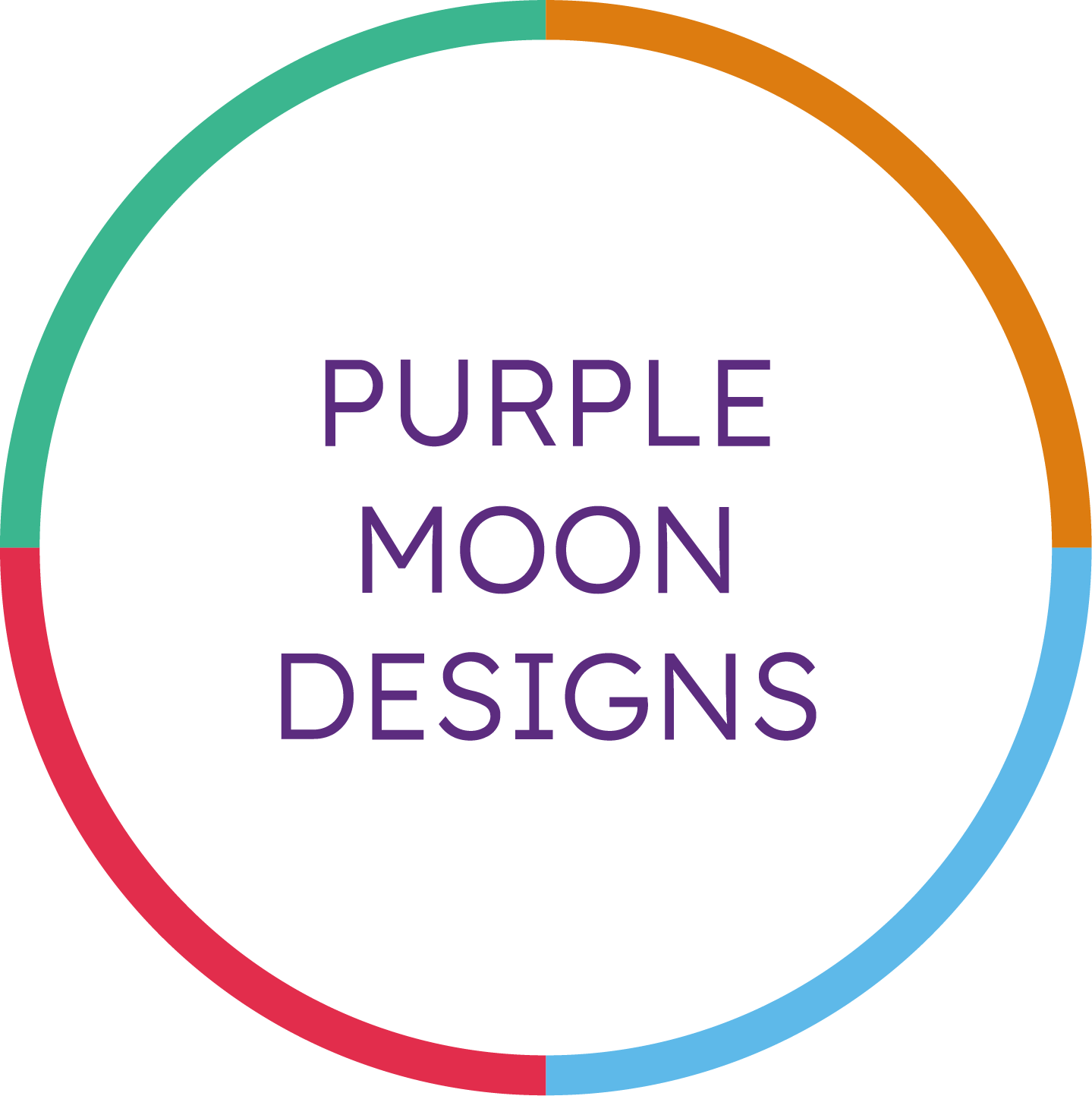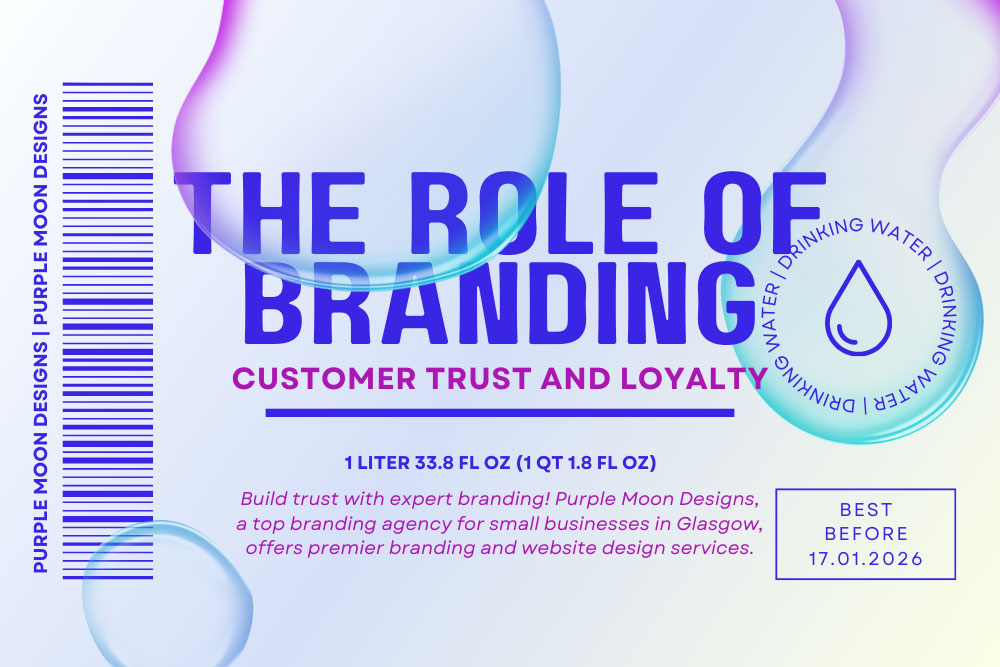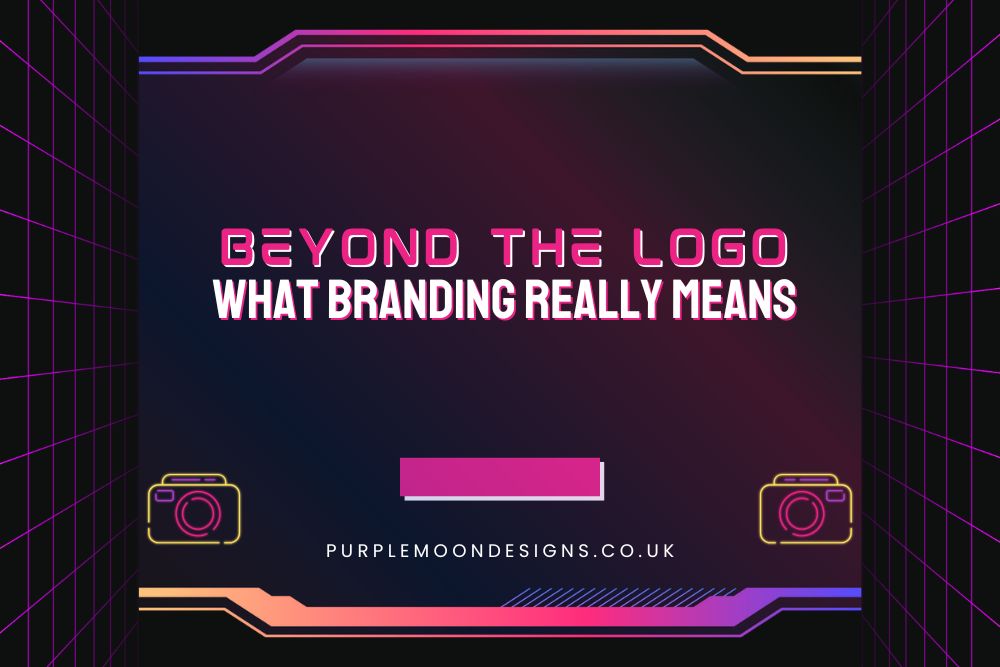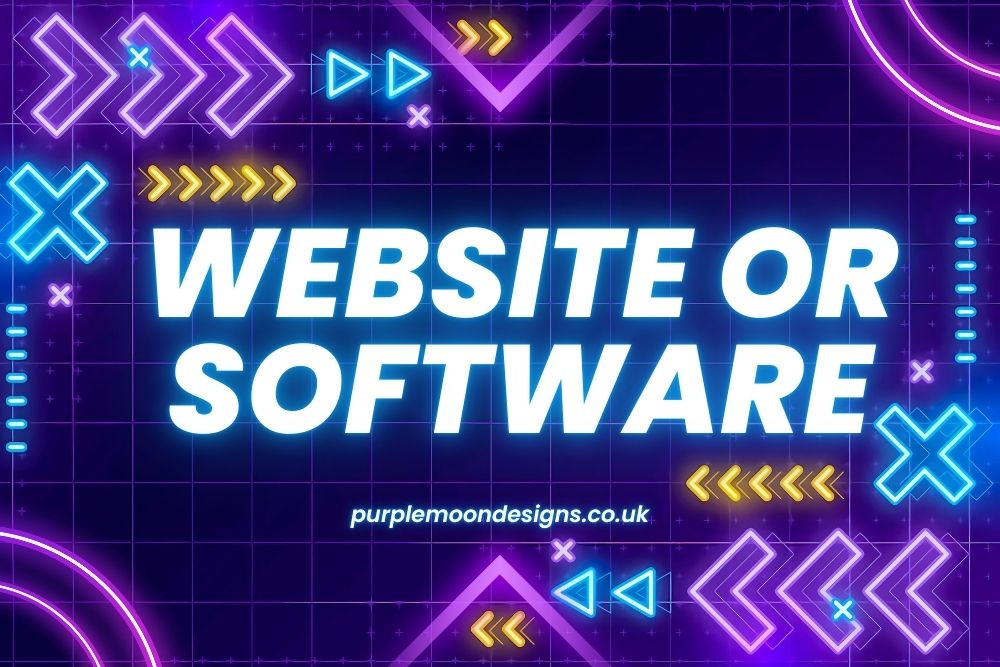Brand branding is the backbone of any successful business, shaping how customers perceive a company and fostering trust. It is a multi-faceted process that goes beyond simple visual elements like logos and names, encompassing the overall customer experience and influencing marketing strategies. For small businesses in Glasgow, partnering with a Branding Agency for Small Businesses Glasgow. Purple Moon Designs can help create meaningful connections with customers. As a leading branding and website design company in Glasgow, we understand the intricate relationship between branding, trust, and loyalty.
What is Branding, and Why is It Important?
Branding is more than a logo or slogan; it encompasses the entire reputation and perception of your business. A strong brand image plays a crucial role in shaping consumer perceptions and influencing purchasing decisions. A strong brand:
- Establishes recognition and trust.
- Creates an emotional connection with customers.
- Builds long-term customer loyalty.
Effective brand management is essential for creating and maintaining a brand, involving both tangible elements like packaging and intangible aspects such as audience perception. Customer loyalty is not just about repeated purchases; it’s about commitment. Loyal customers trust your brand, advocate for it, and help drive growth through word-of-mouth.

Branding vs. Marketing
Branding and marketing are two distinct yet interconnected concepts that play crucial roles in a business’s success. While they are often used interchangeably, understanding their differences is key to leveraging their full potential.
Branding is the process of creating and maintaining a unique identity for your business, product, or service. It involves developing a consistent visual identity, tone, and messaging that resonate with your target audience. This includes crafting a solid brand strategy, establishing brand guidelines, and ensuring that all marketing materials, including social media posts, advertising, and packaging, align with your brand’s values and personality. The goal of branding is to create an emotional connection with your audience, fostering trust and loyalty.
On the other hand, marketing is about promoting and selling your product or service. It encompasses various tactics such as advertising, public relations, content marketing, and social media marketing. The primary objective of marketing is to drive sales, increase brand awareness, and build customer loyalty.
While branding focuses on creating a strong foundation and identity, marketing leverages that identity to engage the target audience and achieve business goals. A robust brand identity enhances marketing efforts by providing a consistent and compelling message that resonates with customers.
In essence, branding sets the stage for effective marketing. Together, they work hand-in-hand to build a successful brand that not only attracts but also retains loyal customers.
How Branding Builds Trust and Loyalty
Creating a Strong Brand Identity
Your brand identity is what sets you apart in a crowded market. It includes:
- A memorable logo and consistent color scheme. Brand values are essential in creating a strong brand identity, as they define the core principles and mission of your company.
- Clear messaging that reflects your values. Aligning branding strategies with a brand’s values is crucial for maintaining customer loyalty and attracting new audiences.
- Uniform branding across all platforms and materials.
Consistency builds familiarity, and familiarity breeds trust. When customers encounter your cohesive identity regularly, they develop a sense of reliability and connection.
Determine Your Target Audience
Determining your target audience is a fundamental step in the branding process. Your target audience comprises the individuals who are most likely to be interested in your product or service and who will benefit from it the most. Understanding this group is essential for creating a brand identity that resonates with them and for developing marketing strategies that effectively reach and engage them.
To identify your target audience, start with comprehensive market research. Gather demographic information such as age, gender, income, education level, and occupation. Additionally, delve into psychographic data, which includes values, interests, and lifestyle choices. This holistic approach provides a clearer picture of who your potential customers are.
Once you have this data, create detailed buyer personas that represent your ideal customers. These personas should include information about their needs, preferences, pain points, and behaviors, as well as their goals and aspirations. By humanizing your target audience, you can tailor your brand identity and messaging to speak directly to them.
Understanding your target audience allows you to craft a brand identity that truly resonates. It also informs your marketing strategies, ensuring that your efforts are focused on engaging the right people in the most effective ways. This targeted approach not only enhances brand recognition but also fosters deeper connections and loyalty among your customers.

Building Emotional Connections
Emotions drive decisions. Effective branding taps into these emotions through:
- Storytelling: Share the journey and mission behind your business.
- Shared values: Align your brand with causes or beliefs your audience supports. Existing customers can provide valuable insights and feedback for branding efforts, helping to identify consistent messaging and what is appealing or lacking in your services.
- Nostalgia and relatability: Use imagery and messaging that resonates deeply.
Customers with an emotional attachment to your brand are more likely to remain loyal.
Delivering Consistent Value
Consistency is key in fostering loyalty. Customers need to trust that they will receive the following:
- High-quality products or services.
- Exceptional customer service.
- Reliable and transparent communication.
Meeting or exceeding expectations consistently reinforces your brand promise.
Fostering Brand Trust
Trust is the foundation of customer loyalty. Build it by:
- Prioritizing transparency and integrity.
- Addressing customer concerns promptly.
- Delivering on promises.
Trustworthy brands are seen as dependable partners, inspiring long-term loyalty.
Strategies to Enhance Customer Loyalty
Personalisation
Today’s customers value tailored experiences. Personalization can include:
Exclusive offers are based on past purchases.
Custom recommendations.
Direct, meaningful interactions.
Reward Programs
Loyalty programs incentivize repeat purchases. Examples include:
- Points-based systems.
- Exclusive discounts or early access to products
- VIP benefits for frequent customers.
Exceptional Customer Service
Great customer service fosters positive experiences and strengthens loyalty. Focus on:
- Fast response times.
- Personalized solutions.
- Active listening to customer feedback.
Community Engagement
Create a sense of belonging by:
- Hosting events or webinars.
- Encouraging user-generated content.
- Building social media communities where customers can connect.
Branding Techniques to Strengthen Loyalty
Compelling Storytelling
Tell stories that highlight your brand’s mission, values, and impact. Customers connect deeply with narratives that resonate emotionally.
Consistent Branding
Ensure your visual and verbal messaging is aligned across all platforms. Consistency builds recognition and trust over time.
User-Generated Content
Encourage customers to share their experiences. Positive testimonials and authentic reviews act as powerful social proof.
Commitment to Security
Data security is critical. Invest in robust systems to protect customer information and demonstrate your commitment to their privacy.
Brand Voice
Your brand voice is the tone and language you use to communicate with your target audience. It is a critical component of your brand identity, helping to create an emotional connection with your customers and setting you apart from competitors.
A strong brand voice should be consistent across all marketing materials, including social media posts, advertising, and packaging. It should also be reflected in the language and tone used by your customer service team and in any other interactions your customers have with your brand.
To develop a compelling brand voice, consider the personality and values of your brand, as well as the needs and preferences of your target audience. Analyze the tone and language used by your competitors and identify ways to differentiate yourself.
Key considerations when developing your brand voice include:
- Tone: Decide whether your brand voice is formal or informal, serious or playful.
- Language: Choose the type of language you will use, whether it is technical or conversational.
- Personality: Define the personality of your brand, whether it is friendly, professional, or something else.
- Values: Reflect your brand’s values, such as a commitment to sustainability or social responsibility.
By developing a strong brand voice, you create a consistent and compelling brand identity that resonates with your target audience, fostering trust and loyalty.
Measuring Brand Success
Measuring brand success is essential for understanding the effectiveness of your branding efforts and making data-driven decisions to enhance your brand. Several key metrics can help you gauge your brand’s performance:
- Brand Recognition: This measures the percentage of people who recognize your brand and can recall it from memory. High brand recognition indicates strong brand presence and visibility.
- Brand Awareness: This metric assesses the percentage of people who are aware of your brand and its products or services. It reflects the reach and impact of your branding efforts.
- Brand Preference: This measures the percentage of people who prefer your brand over others in the same category. It indicates the strength of your brand’s appeal and differentiation.
- Brand Loyalty: This metric evaluates the percentage of customers who are loyal to your brand and continue to purchase from you over time. High brand loyalty signifies strong customer relationships and satisfaction.
- Net Promoter Score (NPS): This measures the likelihood of customers recommending your brand to others. A high NPS indicates strong customer advocacy and satisfaction.
To measure these metrics, you can use various tools and techniques, including:
- Surveys and Focus Groups: These provide valuable insights into customer perceptions and attitudes towards your brand.
- Social Media Analytics: These offer data on brand awareness, engagement, and sentiment.
- Customer Feedback: This provides insights into customer satisfaction and loyalty.
- Market Research: This offers data on brand recognition, awareness, and preference.
By regularly measuring brand success, you can gain a deeper understanding of your brand’s strengths and weaknesses. This enables you to make informed, data-driven decisions to improve your brand and drive business growth.
Brand Valuation
Brand valuation is the process of estimating the economic value of a brand. Understanding your brand’s value can provide critical insights for strategic decision-making and resource allocation. There are several methods to estimate brand value:
- Financial Valuation: This method estimates the financial value of a brand based on its revenue, profitability, and other financial metrics. It provides a clear picture of the brand’s contribution to the company’s financial performance.
- Market Valuation: This approach estimates the value of a brand based on its market share, customer loyalty, and other market metrics. It reflects the brand’s position and competitiveness in the market.
- Brand Equity Valuation: This method estimates the value of a brand based on its brand awareness, brand preference, and other brand equity metrics. It highlights the intangible assets that contribute to the brand’s overall value.
Brand valuation is important for several reasons:
- Informed Decision-Making: Understanding the value of your brand helps you make informed decisions about investments and resource allocation.
- Stakeholder Communication: Communicating the value of your brand to stakeholders, including investors, customers, and employees, can enhance their confidence and support.
- Monitoring and Tracking: Regularly valuing your brand allows you to monitor changes in brand value over time and adjust your branding strategies accordingly.
By valuing your brand, you gain a deeper understanding of its economic value, enabling you to make strategic decisions that drive business growth and increase brand value.
Why Choose Purple Moon Designs?
At Purple Moon Designs, we specialize in helping businesses grow by enhancing their brand identity. Whether you’re a small business looking for a branding agency for a small business in Glasgow or need a comprehensive solution from a Branding and Website Design Company in Glasgow, we deliver results that build trust and loyalty.
Branding plays a pivotal role in fostering customer trust and loyalty. From creating a compelling brand identity to delivering consistent value, every aspect of branding contributes to how customers perceive and connect with your business. By focusing on emotional connections, trust-building strategies, and personalized experiences, companies can cultivate lasting relationships with their customers.
Let Purple Moon Designs help you achieve your branding goals. Together, we can build a brand that inspires trust, loyalty, and long-term success.





